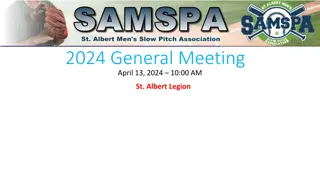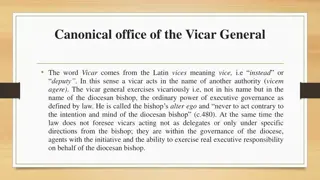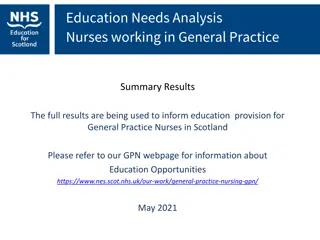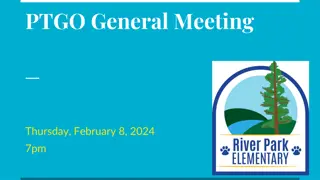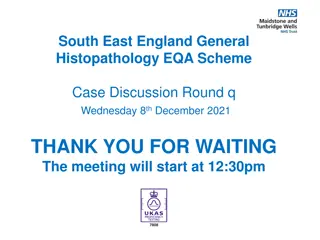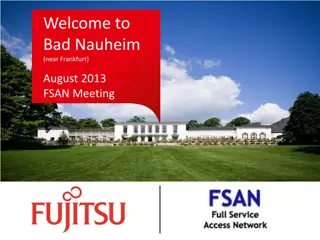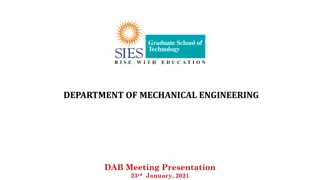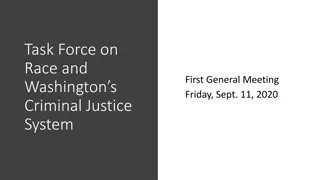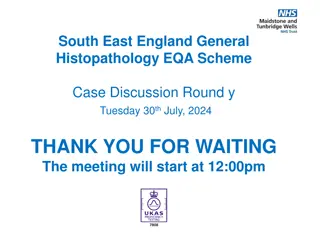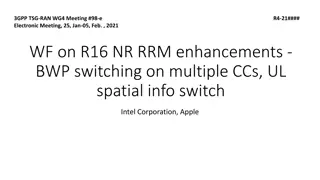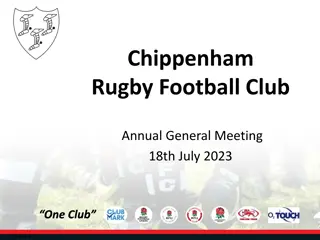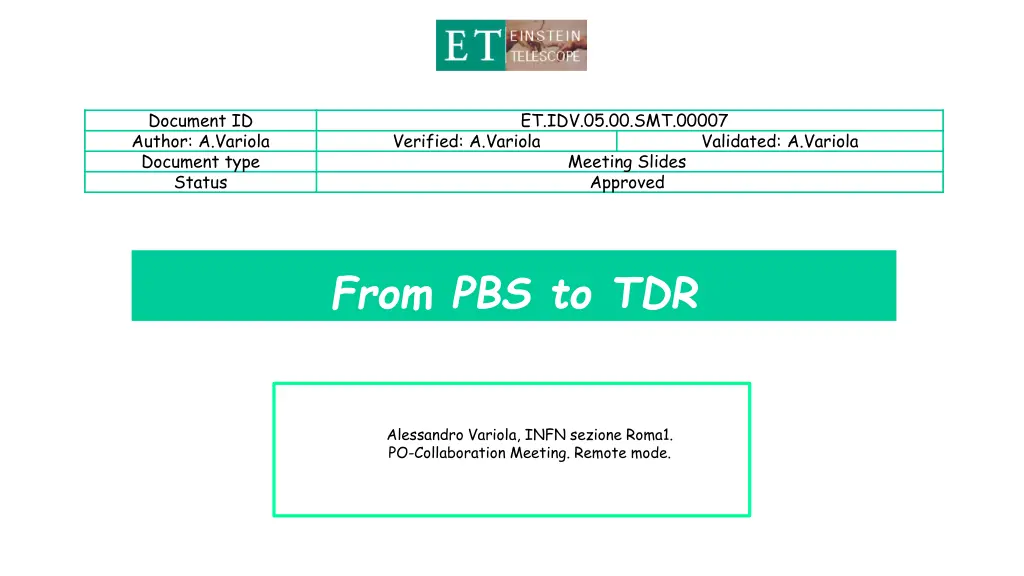
Start Working Project-Oriented: Importance of Project Mode
Learn why working project-oriented is crucial in organizational frameworks like ETO, CERN, and ET-PP. Discover the benefits of defining project goals, breaking down activities, organizing work, budgeting, scheduling, and more. Explore the significance of parameters baseline and the transition to the TDR phase in project management.
Download Presentation

Please find below an Image/Link to download the presentation.
The content on the website is provided AS IS for your information and personal use only. It may not be sold, licensed, or shared on other websites without obtaining consent from the author. If you encounter any issues during the download, it is possible that the publisher has removed the file from their server.
You are allowed to download the files provided on this website for personal or commercial use, subject to the condition that they are used lawfully. All files are the property of their respective owners.
The content on the website is provided AS IS for your information and personal use only. It may not be sold, licensed, or shared on other websites without obtaining consent from the author.
E N D
Presentation Transcript
Document ID Author: A.Variola Document type Status ET.IDV.05.00.SMT.00007 Verified: A.Variola Validated: A.Variola Meeting Slides Approved From PBS to TDR Alessandro Variola, INFN sezione Roma1. PO-Collaboration Meeting. Remote mode.
Foreword: why to work project oriented? - At present, in the ETO world we are working in an organization-based framework (Collaboration, ETO, CERN, ET-PP ) - OUR EFFORT is to support the introduction of a general projectmode ..WHY? Starting from the Project definition (activity with a well-defined goal in a certain time) - It helps to define the project goal - It allows to breakdown the project in activity and items (a way to describe a very complex system in many simplest ones) - It gives a method to organize the work - It gives the method to build up the budget and the schedule - It gives a method to define the responsibilities - Other . Alessandro Variola, INFN Roma1. Remote mode.
Together we did a first step: the PBS - It defines the project object (PO) thanks to the breakdown in systems and elements. These are more and more simpler increasing the Tier number. We start to reduce complexity (also if the contrary appears .) - It should have help also to identify the subject that needs further effort in study and design. BUT THE PBS is important not only for the project object description - Starting from PO description we can define: 1) the activities needed to build, integrate and operate it (WBS), 2) the time associated to the activities (Schedule), 3) the object design and its sameness to what is expected by the stakeholders and what is provided by the documentation (Configuration). - The definition of the parameters baseline is one of the configuration processes. - Moreover, it gives an ordinated structure to provide the backbone structure for different analysis process like : Costing, risk analysis, stakeholders' analysis, resources, requirements, nomenclature etc etc. Alessandro Variola, INFN Roma1. Remote mode.
Why to start from the parameters baseline? Change process Unfortunately, we have not proceeded in project mode; we are not working with the natural phases' definition provided in openSE (or other SE frameworks). So, we have to adapt our processes to the present framework. After the PBS it appears that, to allow a coherent effort in the design of the facility and so to finalize the TDR phase, it was mandatory to introduce (as a priority) a change request process. But to implement the change process we must understand: change in respect to what ..? Needs a first phase of BASELINE DEFINITION. This starts from the characters of the (huge) work already provided : the parameters and the layouts Alessandro Variola, INFN Roma1. Remote mode.
The TDR The TDR, in openSE, is the deliverable of the design phase. It describes, at engineering level, the object of the project and the infrastructures It is the snapshot of a part of the BASELINE configuration at a certain moment, where the design is mature to proceed to the indutrialization phases. TDR, usually, is not associated to an approval phase, but it should be a WORK REFERENCE DOCUMENT Change are always possible after the TDR, by means of a change request process. So the TDR first step must consider the definition of the baseline configuration and the introduction of a change process. Alessandro Variola, INFN Roma1. Remote mode.
So.starting from the PBS The PBS, again, represents the perfect backbone to build the parameters and layouts baseline. The natural process is that, once that a responsibleexpert has been identified for each PBS unit (box), he will be in charge of: 1) Identify and define the useful parameters (we see later functional and integration ) 2) Provide the parameters, STARTING FROM THE CDR (the existing reference document). 3) If not on the CDR, provide the reference. 4) Take care about the verification and validation process Alessandro Variola, INFN Roma1. Remote mode.
The PARAMETERS baseline Table of parameters : - Functional parameter: p.ex -> for a pump is the pumping speed (or other). Not the power supply power - Integration parameter: all parameters linked to the integration (beams diameter, FP cavity lengths, needed pressure, ventilation etc etc ). - Functional interfaces. Parameters that are not functional but that has a strong correlation an impact on other parameters. - These can be defined for all the defined elements and for the systems-subsystems. Where not existing, the element study and design needs to be further developed. At the end we will have a parameter oriented- as designed configuration OUR BASELINE Alessandro Variola, INFN Roma1. Remote mode.
Some rules If the parameter is defined by a plot (sensitivity, noise ) or a document: insert a link or the reference (also and especially the CDR) A parameter can be a design specification, an estimated guess, or a fixed constraint (they can change but they need a change process) A template will be provided We will have thousands of datasheets (at present we have not a ready database). So, instructions on how name the file will be provided. Alessandro Variola, INFN Roma1. Remote mode.
Important ATTENTION, this is not a passive process (look in the CDR at the parameters), but an active one, especially in defining WHAT parameters. Once that these parameters are provided it will be possible to : 1) Verify them 2) Validate them 3) Provide the change process Alessandro Variola, INFN Roma1. Remote mode.
Parameters definition What parameters we are talking about? PBS defines the classes . High Tiers and systems characterize the design of a system, as an ensemble of elements integrated to provide a precise performance (i.e. the FP cavity want to store laser power) Low Tiers defines the technical specifications of the single elements (mirrors reflectivity) At the end a communication strategy must be implemented to provide to everybody the validated parameters baseline and the change process description All this if possible, supported by a first database version .. Alessandro Variola, INFN Roma1. Remote mode.
Parameters Functional parameters : Parameters that characterize the function and the consequent performance of the specific PBS unit. (laser wavelength) Parameters that has an impact on the PBS Tier n+m (so proceeding in the breakdown) units, when applicable. Parameters that has a major impact on the final design of other units (when applicable) a) b) c) b and c (cryoplants vibration, wire magnetic coupling) This are Functional Interfaces Integration parameters : a) Parameters that has an impact on the design and definition of unit n of the civil infrastructure PBS (effective diameter of a vacuum module, integrated pump dimensions) b) Parameters that has an impact on the integration of the interferometer systems and subsystems (weight of the mirrors) c) Parameters expressing utilities requirements (specifications, less then, more than ) (laser load or total power) Alessandro Variola, INFN Roma1, Parameters and Layouts Meeting. Remote mode.
It is EXTREMELY important, in this phase, that the expert responsible IDENTIFY the parameters, also if they are not still quantified . This requires to spend time on this first process (identification) with different loops with the verifier (the responsible for the upper PBS unit see later) This will further help in defining the missing areas . Alessandro Variola, INFN Roma1. Remote mode.
Some example (from CDR, interferometers table) Ok, but also in integration if not specified (redundancy) Ok, the power defines the interferometer performance Ok, it defines cryo performance and not cryo specifications In the mirrors PBS units In the laser PBS units This should go in the filter cavity unit IF, Squeezing cavity ? Alessandro Variola, INFN Roma1, Parameters and Layouts Meeting. Remote mode.
Arm cavity Arm cavity, ok l is also the wavelength of the laser, but it also define the cavity. This is not an overlap (two different units). In general it is not assumed that the two are equal. So they must have different names. Alessandro Variola, INFN Roma1, Parameters and Layouts Meeting. Remote mode.
Mistakes The most important thing to be controlled is not to have the SAME parameters, with two different values, associated to two different PBS units . We must check Mistakes will come .it is unavoidable, we will debug the full process by working on it! Alessandro Variola, INFN Roma1. Remote mode.
Verification rule Alessandro Variola, INFN Roma1. Remote mode.
Example Are these the same person? If the same person PBS HF Responsible for the unit 1.1.1.2.11.3 CO2 laser pulling machine Provide the parameters table The list is provided, for verification, to the Responsible of unit 1.1.1.2 Test mass suspension The list is provided, for verification, to the Responsible of the unit 1.1.1.2.11 Production Tools Not the same person Verification Problem Verification List provided, for final verification, to the Responsible of unit 1.1 HF Interferometer The final list is provided for the Loop of validation (to be decided) Alessandro Variola, INFN Roma1. Remote mode.
Roles As far as the project Office is concerned there are three main actors: C. Olivetto - Configuration manager: ensures that parameters are unambiguously defined across the project areas (science, engineering, procurement, inventory) and that they are available. L. Latronico - Quality manager: ensures that parameters are maintained across the life of the project (proposal, construction, operations, maintenance). A. Rocchi - Technical coordinator: ensures that parameters meets the project requirements (technical and scientific). A. Variola (PO Head) - oversight ensures that parameters are defined and updated Collaboration and ED It is necessary to provide a OBS with responsibilities. If, in some branches, only a name appears it means that the knowledgeableengineer criteria has not been well applied in the PBS Alessandro Variola, INFN Roma1, Parameters and Layouts Meeting. Remote mode.
Next We still have to provide a good environment Let-s start to> 1) Assign responsibilities 2) Fill the Tables 3) First verification 4) Keep the tables at the first verification loop 5) An agile parameters change process will be implemented for this phase 6) Further instruction in the next meeting Alessandro Variola, INFN Roma1, Parameters and Layouts Meeting. Remote mode.
TDS references for Parameters and Layouts WG SLIDES: https://apps.et-gw.eu/tds/?content=3&r=18407 https://apps.et-gw.eu/tds/?content=3&r=18408 Meeting summary https://apps.et-gw.eu/tds/?content=3&r=18406 Alessandro Variola, INFN Roma1. Remote mode.



